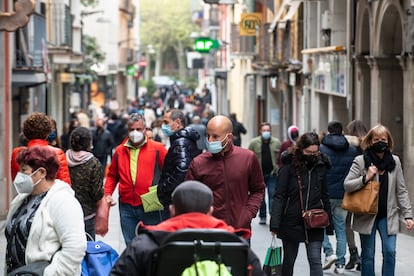Spain’s population falls by 106,000 people in 2020 after four years of growth
Demographers blame high deaths and low migration caused by the coronavirus pandemic for the decline, which in relative terms was greatest in Asturias


Spain’s population fell by 106,146 people last year, the first drop after four straight years of growth. That’s according to provisional data released on Tuesday by the National Statistics Institute (INE) and based on local registry statistics.
Of the country’s 47.3 million registered residents, 88.6% have Spanish citizenship (41.9 million) and 11.4% are foreign nationals (5.4 million). Demographers consulted by this newspaper said that factors such as deaths from the coronavirus pandemic and decreased migration flows due to border closures have played a role in this dip in Spain’s registered population. A fall in the birth rate has also influenced the overall decline to a certain degree.
Every new statistic serves to confirm the impact of the Covid-19 health crisis on Spain’s demographics. Earlier this year, the INE released provisional figures showing a historically high number of deaths and a record low number of marriages in 2020. Now the figures are showing a 0.2% reduction in Spain’s population, which has been felt more intensely among Spanish nationals in absolute terms (79,815 versus 26,331 foreign residents). Expressed as a percentage, however, the drop is bigger among the foreign community: 0.5% compared with 0.2%.
“What we’re seeing is an interruption of the continuous growth of the last four years due to a very serious event, a pandemic, that has caused disruptions in every aspect of society – from a traumatic situation in the health system, which has caused high mortality, to individual movement constrained by the border closures,” explains Diego Ramiro, director of the Institute for Economics, Geography and Demographics of the National Research Council (CSIC).
This expert adds that fewer births have also played a role, if a smaller one, on the population decline. Before the Covid-19 pandemic there was already a downward curve in birth and fertility rates. But the health crisis has intensified the trend. The INE’s early estimates show a 10% drop in November 2020 compared with the same month in 2019, followed by a drop of over 20% in December. The lower birth figures for this latter month show the first effects of confinement, as those babies were conceived in March 2020, when a three-month lockdown began. Many couples have since postponed having children due to economic and health-related uncertainties.
The most densely populated regions of Spain on January 1, 2021 were Andalusia, Catalonia and Madrid. At the other end of the spectrum, La Rioja, Cantabria and Navarre had the smallest registered populations. The number of registered residents has dropped in most Spanish regions over the last year.
Joaquín Recaño, a researcher at the Center for Demography Studies who teaches demographics at the Autonomous University of Barcelona, stresses the role played by deaths and migration. “The main cause is deaths. This can be seen in the regions that felt the pandemic more intensely,” he notes. In absolute terms, the regions that lost the most registered residents were Madrid (34,297 people), Catalonia (23,551) and Castilla y León (13,637).
“In relative terms, after [the North Africa exclave cities of] Ceuta and Melilla, the population drop is headed by Asturias, one of the regions with the oldest populations (0.7%), followed by Castilla y León (0.6%), Madrid and Extremadura (both with 0.5%),” adds Recaño.
Leaving the cities
Statistics also show a rise in registered residents in Murcia, Castilla-La Mancha and Cantabria. “We’ll have to analyze internal-population movements. It’s possible that some people left the big cities to go live elsewhere,” notes this expert. Last year, there was a drop of 37,870 EU nationals registered as residents of Spain. Meanwhile, registered non-EU residents grew by 11,539 individuals.
The overall population decline of 2020 is expected to be felt again in 2021, given that the effects of the pandemic are not yet over. “Our population has been growing for years, basically due to immigration. The crisis has suddenly halted those dynamics, which is something that also happened during the previous economic crisis,” notes Albert Esteve, director of the Center for Demography Studies at the Autonomous University of Barcelona. “It is to be expected that the drop will continue in 2021; it will all depend on how the economy recovers and whether mobility restrictions are eased, but probably there won’t be time enough for immigration to recover.”
5,000 villages of under 1,000 souls
The INE data also shows that of Spain’s 8,131 municipalities, 5,002 have a registered population of under 1,000 people. Castilla y León, Castilla-La Mancha and Aragón have the highest number of these sparsely populated villages, while the Canary Islands, Murcia and the Balearic Islands have the lowest.
English version by Susana Urra.
Tu suscripción se está usando en otro dispositivo
¿Quieres añadir otro usuario a tu suscripción?
Si continúas leyendo en este dispositivo, no se podrá leer en el otro.
FlechaTu suscripción se está usando en otro dispositivo y solo puedes acceder a EL PAÍS desde un dispositivo a la vez.
Si quieres compartir tu cuenta, cambia tu suscripción a la modalidad Premium, así podrás añadir otro usuario. Cada uno accederá con su propia cuenta de email, lo que os permitirá personalizar vuestra experiencia en EL PAÍS.
¿Tienes una suscripción de empresa? Accede aquí para contratar más cuentas.
En el caso de no saber quién está usando tu cuenta, te recomendamos cambiar tu contraseña aquí.
Si decides continuar compartiendo tu cuenta, este mensaje se mostrará en tu dispositivo y en el de la otra persona que está usando tu cuenta de forma indefinida, afectando a tu experiencia de lectura. Puedes consultar aquí los términos y condiciones de la suscripción digital.
More information
Últimas noticias
Most viewed
- Reinhard Genzel, Nobel laureate in physics: ‘One-minute videos will never give you the truth’
- Oona Chaplin: ‘I told James Cameron that I was living in a treehouse and starting a permaculture project with a friend’
- Pablo Escobar’s hippos: A serious environmental problem, 40 years on
- Chevy Chase, the beloved comedian who was a monster off camera: ‘Not everyone hated him, just the people who’ve worked with him’
- Why we lost the habit of sleeping in two segments and how that changed our sense of time









































